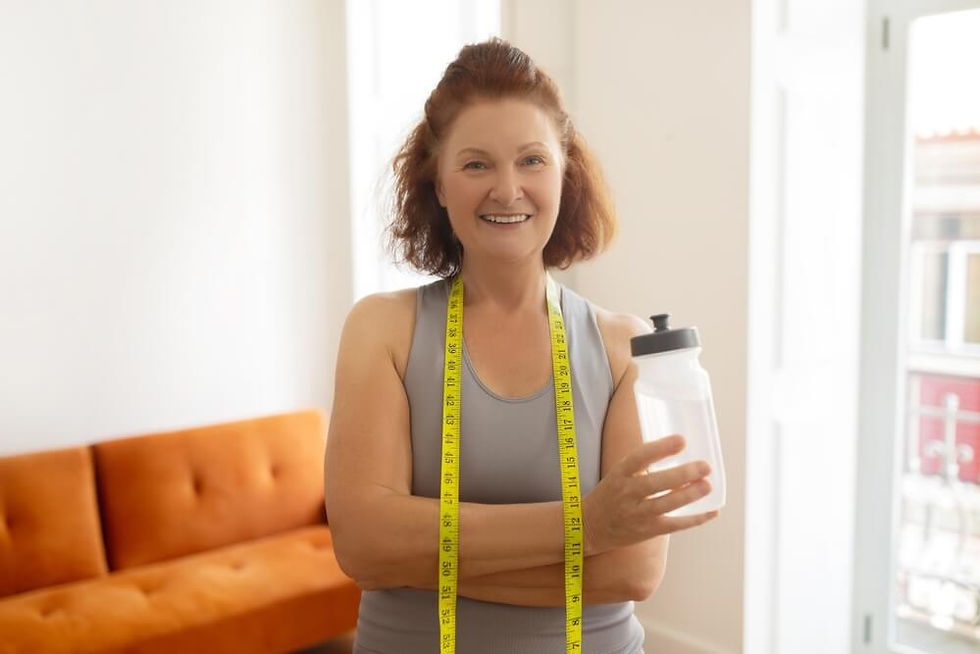The Best Types of Exercise for Women in Perimenopause
- Jacky Dempsey
- Aug 27
- 4 min read

Perimenopause can feel like a time of chaos for your body, and your confidence. As hormone levels begin to fluctuate, many women experience changes such as weight gain (especially around the middle), poor sleep, low energy, and reduced motivation. But there’s one powerful tool that can help you feel more in control, improve your physical and emotional wellbeing, and even ease your symptoms: exercise.
If you’re looking for the best exercise for perimenopause weight loss, the good news is that you don’t have to commit to extreme workouts or punishing regimes. The most effective routine is one that works with your changing body-not against it. In this blog, we’ll explore the best types of exercise for women in perimenopause, and how to get started safely and sustainably.
Why Exercise Matters During Perimenopause
During perimenopause, oestrogen levels begin to decline, which affects everything from your metabolism and bone density to your mood and sleep. Regular movement can help:
Support weight management and fat loss
Build and maintain lean muscle
Improve cardiovascular health
Strengthen bones and reduce osteoporosis risk
Boost energy and reduce fatigue
Relieve anxiety, brain fog and low mood
Improve sleep quality
Most importantly, exercise helps you reconnect with your body, rebuild confidence, and feel more in control during a time that can feel anything but.
What’s the Best Exercise for Perimenopause Weight Loss?
When it comes to exercise for perimenopause weight loss, the magic lies in a balanced approach. Here are the top types of exercise that support fat loss, hormone balance, and long-term wellbeing.
Strength Training
If there’s one form of exercise every perimenopausal woman should include, it’s strength training. As oestrogen levels drop, so does muscle mass-and since muscle helps you burn more calories at rest, this can make weight loss even harder.
Strength training helps you build lean muscle, improve insulin sensitivity, and boost your metabolism, all of which support fat loss. You don’t need to lift heavy weights to benefit; resistance bands, bodyweight exercises like squats and lunges, or light dumbbells are a great place to start.
Aim for 2–3 sessions per week focusing on major muscle groups.
Walking (Especially Brisk Walking)
Walking is underrated, especially when done regularly and at a brisk pace. It’s gentle on your joints, easy to fit into your routine, and fantastic for fat-burning, stress relief, and cardiovascular health.
What makes walking even more powerful during perimenopause is that it doesn’t spike cortisol (your stress hormone) the way some high-intensity exercise might. And since high cortisol can lead to stubborn belly fat, walking can actually be more effective than pushing yourself too hard.
Aim for 30 minutes a day, most days of the week. Bonus points for getting out in nature!
Low-Impact Cardio (Like Cycling or Swimming)
Low-impact cardio helps keep your heart and lungs strong, burns calories, and supports mental health. Swimming, cycling, and even dancing are fantastic options that are easy on your joints but still get your heart rate up.
This kind of movement can also reduce hot flushes and help manage anxiety by stimulating endorphin release.
Aim for 2-3 times per week, ideally at a moderate intensity where you can still hold a conversation.
Yoga and Pilates
If perimenopause has left you feeling stiff, tense, or anxious, yoga and Pilates are your best friends. These practices support flexibility, core strength, posture, balance, and perhaps most importantly, nervous system regulation.
Chronic stress is one of the biggest contributors to midlife weight gain, and gentle movement like yoga helps soothe the stress response. Certain poses also support pelvic floor health and digestion, which can be affected during perimenopause.
Aim for 1-2 sessions per week, or even short daily stretches.
HIIT (High-Intensity Interval Training)
HIIT involves short bursts of intense activity followed by rest periods. While this isn’t the best fit for everyone, in moderation it can be a powerful fat-burning tool and improves both aerobic and anaerobic fitness.
However, caution is key. Overdoing HIIT can raise cortisol and work against you. If your energy is low, or you’re not sleeping well, it’s better to focus on more restorative exercise until your body feels ready.
Aim for 1–2 sessions per week max, and listen to your body.
How to Create a Perimenopause-Friendly Routine
The key to long-term success is to work with your hormones, not against them. Here are a few tips:
Consistency over intensity: It’s better to move regularly than to go all-out once a week.
Cycle your workouts: Your energy levels may fluctuate with your hormone cycle-plan gentler sessions during lower-energy weeks.
Prioritise recovery: Rest, sleep, hydration, and self-care are just as important as your workout.
Fuel your body: Pair your exercise routine with balanced nutrition to support energy, recovery, and muscle repair.
Listen to your body: If you feel burnt out, irritable, or exhausted after a workout, dial it back.
You Don’t Have to Do This Alone
Starting or adjusting a fitness routine in perimenopause can feel overwhelming, especially when your body isn’t responding the way it used to.
That’s where personalised support can make all the difference. As a certified Health & Wellness Coach specialising in midlife and menopause, I help women create sustainable, confidence-boosting exercise routines that support long-term weight loss, energy, and wellbeing.
If you’re tired of feeling stuck and want to feel like yourself again, I’d love to help. Together, we’ll develop a plan that fits your lifestyle, honours your body, and supports your goals, without extremes or quick fixes.
Ready to find the best exercise for your perimenopausal body? Let’s work together to build a routine that helps you thrive-mind, body and spirit.
Book a free discovery call today or get in touch to learn more.






